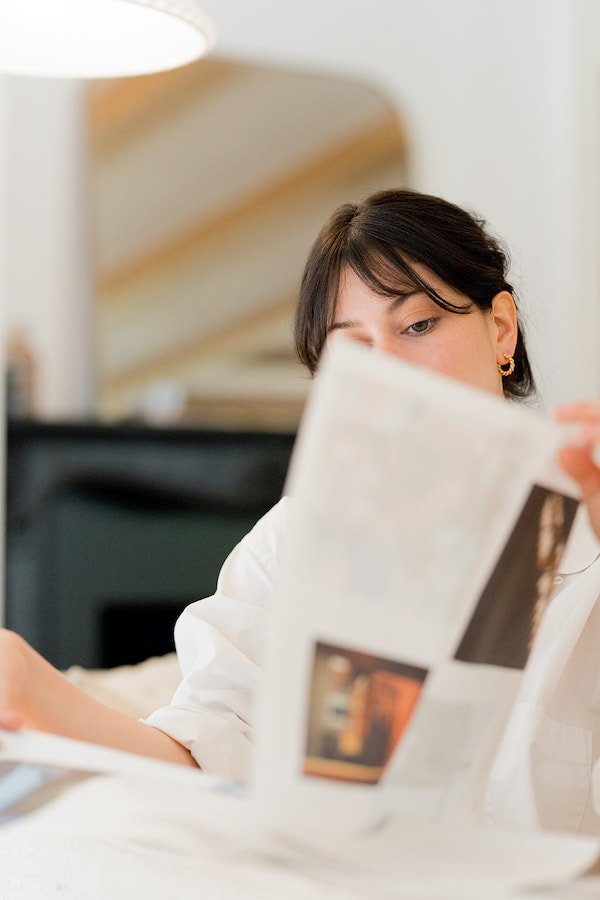
Playlist Ideas: Music For Every Moment Of Your Day
Sounds For Self
Growing up, I loved going to concerts. I saw M.I.A. at Philadelphia’s Electric Factory in 2007; Santigold opened for her but was still spelling it Santogold. Later, when working as a music journalist, I saw Zoë Kravitz perform as the frontwoman for Lolawolf at Los Angeles’ Echo in 2014. And pre-COVID, in September 2019, I convinced myself that maneuvering the parking lot of the LAX-adjacent Forum was worth it for Bon Iver. (It was.)
But on the days I can’t fulfill that passion in person, which is most of them, I have to settle for Spotify, digital sound baths, and skipping vinyl. Sure, scream-singing alongside sweaty, like-minded fans is its own experience, but playing music at home is no less satisfying. At a time when many of us are staying in to keep safe from the spread of COVID-19, music can be a source of inspiration, emotion, and community.
“Listening to music can also make you feel supported and less lonely.”
“Most [people] will have already experienced how music can improve your mood and reduce your stress,” says Drexel University professor and certified musical therapist Joke Bradt, Ph.D. “Listening to music can also make you feel supported and less lonely. [And] research has shown that listening to it and singing improves your immune system.”
I often find myself selecting sounds that mimic my movement: downtempo tracks when I need to embrace and embody slowness, optimistic ones when I need uplifting. The sheer amount and assortment of music available makes it a near malleable entity, one that can serve as a personalized catalyst for both pleasure and productivity—and everything in between. So, here’s how I improve my day with music, plus a few tips on how you can too.
“The sheer amount and assortment of music makes it a near malleable entity that can serve as a personalized catalyst for pleasure, productivity, and everything in between.”
Music For Mornings
My father would likely feel proud—or slighted 😏—to learn that I now spend my mornings listening to the same jazz he insisted on playing for me as a child, the same sounds I rolled my eyes at and declared boring because I couldn’t sing along. Now I bask in the genre’s lack of language; another voice would feel like an interruption. Because I try to maintain an intentional pace in the morning, moving from meditation to breakfast with tranquil ease before life’s responsibilities require more speed, the long-stretched horns of smooth jazz feel like support.
But if you’re unlike me, and require more propulsive sounds to propel you out of bed, you have neuroscientist and music psychologist David M. Greenberg on your side. His research examines music in connection to neuroscience, social science, clinical treatment, and more, and he once revealed his perfect morning playlist to include wildly energetic fare like Coldplay’s stadium-sized “Viva La Vida” and the late Avicii’s massive folktronica hit “Wake Me Up.” If power-pop is your morning jam, then, well, jam.
🎶 A Playlist To Try | The Lazy Jazz Cat Playlist
Music For Joy (& Movement)
When you’re feeling in a celebratory mood (and even when you’re not, but would like to get there), music can be your motivator.
“Music impacts areas of the brain that play a crucial role in releasing dopamine and endorphins.”
“Music is not just a feel-good thing,” says Bradt. “Neuro-imaging studies have shown that it impacts areas of the brain that play a crucial role in reducing stress hormones and releasing dopamine and endorphins, i.e., the ‘feel-good’ hormones.”
Other ways to naturally boost your endorphins include laughing, dancing, and having a glass of wine—all of which sound like the makings of a perfect day to me. So make sure you soundtrack your special occasions, especially with some upbeat anthems! After all, the driving force behind music’s stimulating sounds is BPMs, or beats per minute.
Unsurprisingly, this makes music a great workout buddy. When timed with the tempo of an exercise, it can boost our mood and performance, improving oxygen consumption, distracting us from fatigue, and increasing the length of the workout.
Faster rates (140 BPMs+) can carry us through cardio and high-intensity interval training while measured mid-tempo tracks (80-115) can give rhythm to the repetition of strength conditioning. Lower speeds (less than 100) are perfect for warm-ups and cooldowns.
🎶 A Playlist To Try | The Pumped Pop Playlist
Music For Work
I’ve always been amazed by people who can read books while the television is on or write professionally while playing music at recreationally loud volumes. I, on the other hand, end up mindlessly typing whatever I hear in earshot like I’ve been paid to transcribe it.
“Inoffensive and ambient, the shapeless songs of lo-fi are perfect for focusing. ”
One of the ways I’ve learned to avoid distraction is by listening to lo-fi music. Created free of interference, it’s full of immersive instrumentals that are often unrestricted by traditional time and structure. Inoffensive and ambient, the shapeless songs are perfect for focusing. Liz Brown, a certified sleep science coach, says the reliable consistency of audible frequencies works in the same way.
“White and pink noise are the top two types of music that can boost one’s health and productivity,” says Brown. “White noise, such as fan sounds, is a random signal having equal intensity at different frequencies, giving it a constant power spectral density. Pink noise, such as ocean waves crashing over the shore, are at frequency levels that help improve focus and increase productivity.” Try either the next time you need to concentrate.
🎶 A Playlist To Try | The Good Trade’s Soothing Edit
Music For Cooking & Cleaning
Growing up, my Sunday mornings were spent cleaning the house to the sounds of my father’s Motown classics and mother’s salsa selections. Music that was made to keep people moving on the dance floor kept my sister and me moving from our bedroom to the kitchen to the living room. Charmed by the music’s playfulness, our short attention spans were diverted from the chore.
Without trying, I’ve upheld this habit in my adulthood. Now when I clean my home, crisp vocals on scratchy vinyl ring out and bring a bit of blissful nostalgia to a mundane task. When cooking, I’m emboldened by rhythmic beats from some of the richest food cultures, like traditional Italian arias or Brazilian bossa nova. (Plus, they make pretending to be a world-renowned chef who’s hosting a rousing dinner party much, much easier.)
🎶 A Playlist To Try | The Bossa Nova Playlist
Music For Sleep
My snores come courtesy of sound baths. Though the meditative practice and longtime healing modality is most often practiced in group sessions led by sound therapists, I bring them into my bedroom with apps and YouTube videos.
“The subtle vibrations of sound baths gently shake the day’s stresses away like an Etch-A-Sketch.”
As a structureless symphony of deeply resonating gongs, chimes, cymbals, and bowls, there is little to anticipate or get distracted by. Its subtle vibrations gently shake the day’s stresses away like an Etch-A-Sketch; then, with my body aligned with its frequencies, they rock me to sleep like an ocean wave would.
If you too are anti-silence when sleeping, the increasingly popular ASMR works similarly as audible stimuli (like whispering, tapping, tracing, and brushing) trigger a tingly brain-to-body sensation that assists in relaxation.
🎶 A Playlist To Try | The Tibetan Bowls Playlist
Whatever your preference—Mozart, nature sounds, literal lullabies!—remember that music is a customizable tool. It can be used to support you, wherever you’re at and wherever you’re going.
“Music activates multiple neuronal pathways,” says Flossie Ierardi, director of the music therapy program at Drexel University, “and thus, we are inclined to use it in individual and intentional ways based upon our moods and energy levels. It is not unusual for people to create playlists for various purposes, such as relaxation vs. motivation. And music itself is so varied that we can choose what matches our physical or emotional state at the time, and then subsequently move towards music that reflects our more desired state.”
Looking for some new tunes? Check out The Good Trade on Spotify!
Danielle Cheesman is the Partnerships Lead at The Good Trade. Though born and raised in New Jersey, she’s now based in Los Angeles where you can find her taking pictures, making playlists, or cuddling her pup. Say hi on Instagram!
RELATED READING
Featured image includes model Alexandra Skye wearing shirt by Back Beat Co.




